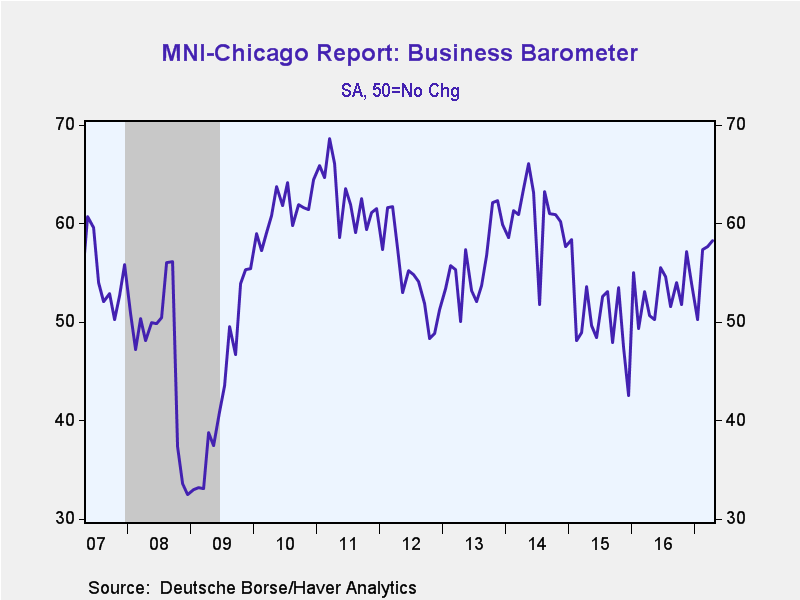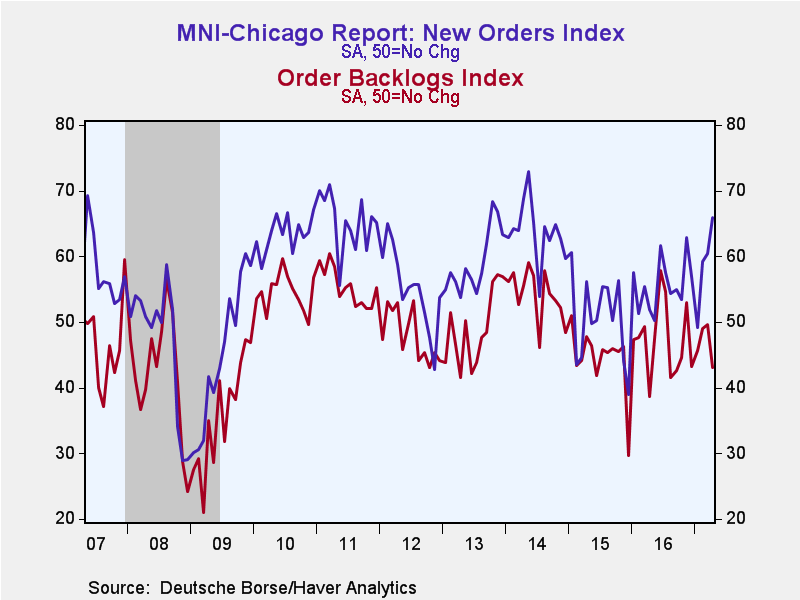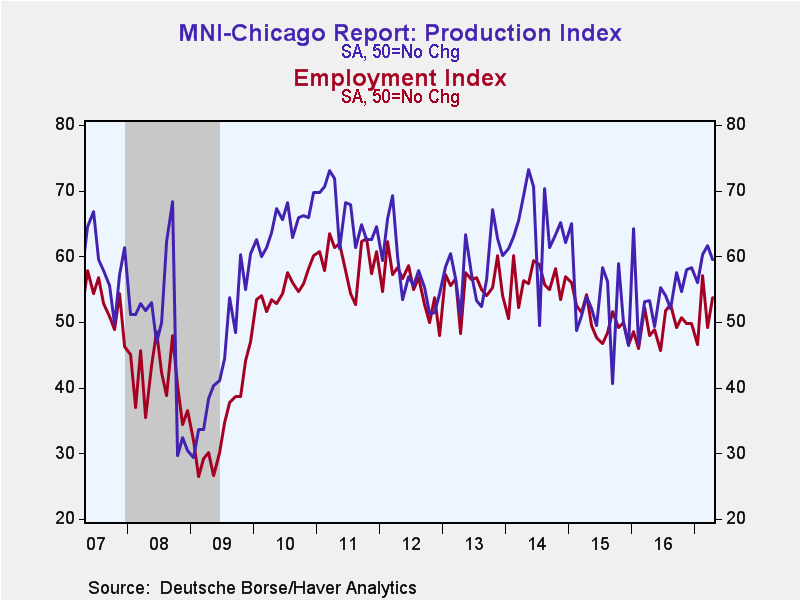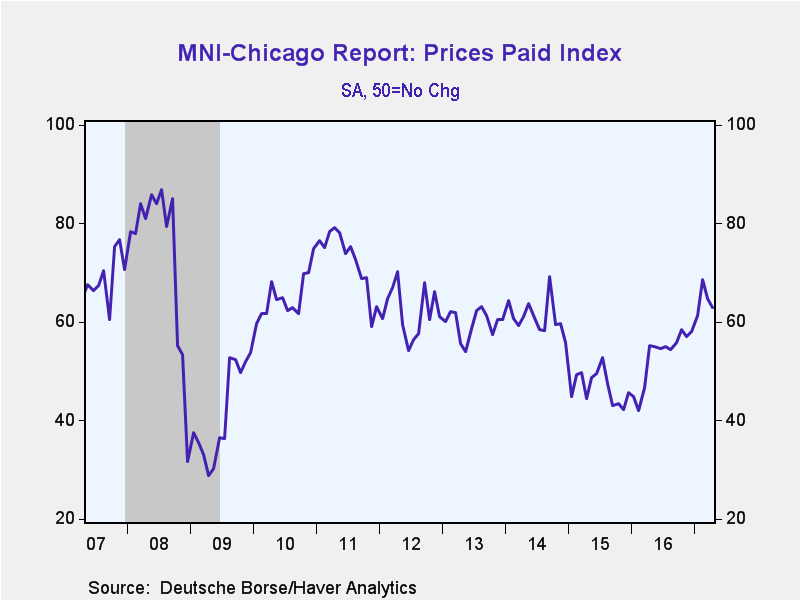 Global| Apr 28 2017
Global| Apr 28 2017Chicago Purchasing Managers Index Strengthens
by:Tom Moeller
|in:Economy in Brief
Summary
The Chicago Purchasing Managers Business Barometer Index for April increased to 58.3 from 57.7 in March. It was the highest level since January 2015. The latest reading exceeded expectations for 57.0 in the Action Economics Forecast [...]
The Chicago Purchasing Managers Business Barometer Index for April increased to 58.3 from 57.7 in March. It was the highest level since January 2015. The latest reading exceeded expectations for 57.0 in the Action Economics Forecast Survey. Readings above 50 indicate growth, while those below 50 show declines in activity levels.
Haver Analytics constructs an ISM-Adjusted Index using the Chicago numbers, comparable to the overall ISM index to be released Monday. The Haver figure improved to 57.7, and remained at the highest level since December 2014. During the last ten years, there has been a 61% correlation between this adjusted Chicago Purchasing Managers index and real GDP growth.
The underlying series exhibited mixed behavior this month. The new orders series surged to the highest level in nearly three years, but production gave back its March increase. The order backlog and inventory series fell but supplier deliveries rose, showing the slowest rate of product delivery since last May.
The employment index rebounded following a sharp March decline. It represented only the second month of growing employment in two years. Twenty five percent (NSA) of respondents reported higher payroll levels. A greatly lessened 12% reported lower employment. During the last ten years, there has been a 74% correlation between the employment index and the m/m change in nonfarm payrolls.
The prices paid barometer declined to the lowest level in three months. A still firm 35% of respondents paid higher prices while eight percent reported lower prices, compared to 11% one year earlier.
The MNI Chicago Report is produced by MNI/Deutsche Borse Group in partnership with ISM-Chicago. The survey covers a sample of over 200 purchasing professionals in the Chicago area with a monthly response rate of about 50%. The ISM-Adjusted headline index is calculated by Haver Analytics using these data to construct a figure with the ISM methodology. Summary data are contained in Haver's USECON database, with detail, including the ISM-style index, in the SURVEYS database. The Consensus expectations figure is available in AS1REPNA.
| Chicago Purchasing Managers Index (%, SA) | Apr | Mar | Feb | Apr '16 | 2016 | 2015 | 2014 |
|---|---|---|---|---|---|---|---|
| General Business Barometer | 58.3 | 57.7 | 57.4 | 50.7 | 53.1 | 50.3 | 60.7 |
| ISM-Adjusted General Business Barometer | 57.7 | 57.2 | 57.6 | 52.0 | 52.0 | 51.6 | 59.3 |
| Production | 59.5 | 61.7 | 60.3 | 53.3 | 54.7 | 52.5 | 64.5 |
| New Orders | 65.9 | 60.4 | 59.2 | 51.9 | 55.7 | 50.4 | 63.8 |
| Order Backlogs | 43.0 | 49.6 | 49.0 | 38.6 | 47.4 | 44.4 | 54.2 |
| Inventories | 53.3 | 60.5 | 58.4 | 49.1 | 47.2 | 52.1 | 55.9 |
| Employment | 53.8 | 49.1 | 57.1 | 48.0 | 49.4 | 50.3 | 56.0 |
| Supplier Deliveries | 56.0 | 54.4 | 52.8 | 57.6 | 52.8 | 52.5 | 56.5 |
| Prices Paid | 62.9 | 64.7 | 68.6 | 55.2 | 53.1 | 46.8 | 61.0 |
Tom Moeller
AuthorMore in Author Profile »Prior to joining Haver Analytics in 2000, Mr. Moeller worked as the Economist at Chancellor Capital Management from 1985 to 1999. There, he developed comprehensive economic forecasts and interpreted economic data for equity and fixed income portfolio managers. Also at Chancellor, Mr. Moeller worked as an equity analyst and was responsible for researching and rating companies in the economically sensitive automobile and housing industries for investment in Chancellor’s equity portfolio. Prior to joining Chancellor, Mr. Moeller was an Economist at Citibank from 1979 to 1984. He also analyzed pricing behavior in the metals industry for the Council on Wage and Price Stability in Washington, D.C. In 1999, Mr. Moeller received the award for most accurate forecast from the Forecasters' Club of New York. From 1990 to 1992 he was President of the New York Association for Business Economists. Mr. Moeller earned an M.B.A. in Finance from Fordham University, where he graduated in 1987. He holds a Bachelor of Arts in Economics from George Washington University.










